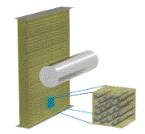Mechanical and Materials Engineering, Department of

Department of Engineering Mechanics: Dissertations, Theses, and Student Research
Date of this Version
2011
Document Type
Thesis
Abstract
Improvised explosive devices (IED’s) are widely used against US and allied forces fighting in Iraq and Afghanistan. Exposure to IED blast may cause blast-induced traumatic brain injury (bTBI). The injury mechanisms are however not well understood. A critical need in bTBI-related research is the ability to replicate the loading conditions of IED blast waves in a laboratory environment. In this work, experimental studies have been carried out to explore the use of the shock tube technique for generating air shock waves that mimic the temporal and spatial characteristics of free-field blast waves and to investigate the blast wave-test sample interactions in such a simulated blast experiment.
To facilitate the studies, new data acquisition and analysis systems for shock tube experiments were developed along with LabVIEW-based software. Techniques for proper mounting of piezoelectric sensors in square shock tubes were also worked out.
Evolutions of the blast waves simulated with a 9-inch square shock tube inside and outside the tube were then investigated by placing a metal cylinder instrumented with piezoelectric sensor array at various locations of interest. The results show that the temporal and spatial characteristics of free-field blast waves can only be replicated deep inside the tube. The lateral expansion as the shock front exits the tube causes unwanted premature release in part of the tube near the exit and complex three-dimensional flow which evolves quickly into subsonic jet flow outside the exit. Motivated by the results, a 28-inch square shock tube adequate for in-tube full scale head/helmet model testing was developed along with a catch tank for blast energy mitigation and noise reduce. Its modular configuration was optimized for best efficiency. Correlations of the peak shock pressure and the positive impulse with the diaphragm burst pressure were determined for various configurations. Accurate (Friedlander) blast wave profiles were obtained for peak pressures from 5.5 to 42 psi and for positive durations from 4 to 9.25 ms.
The interactions between the blast waves simulated with the 9-inch shock tube and cylindrical polycarbonate tubes filled with a mineral oil as idealized two-dimensional skull-brain models were then studied. The results indicate that the sample geometry causes flow separation from lateral surfaces and thus large surface pressure gradients and lateral underpressure pulses as the blast wave engulfs the sample. While the sample front and then the back are compressed, parts of it expand with the underpressure pulses. Such a deformation and the subsequent recovery/oscillation dictate the internal pressure response, which oscillates with multiple full releases and even reversals to underpressure and therefore is temporally different from the pressure wave impinging on the sample front. A thicker shell may reverse from lateral elliptic to front-back elliptic under higher loadings. This can cause cavitations at the front and back walls. These findings have provided, for the first time, experimental measurements of the dynamic response of fluid-filled cylinders (simplified skull-brain models) subjected to blast wave loading.
Advisor: Ruqiang Feng
Included in
Aerodynamics and Fluid Mechanics Commons, Applied Mechanics Commons, Computer-Aided Engineering and Design Commons, Manufacturing Commons, Other Mechanical Engineering Commons, Signal Processing Commons, Structures and Materials Commons


Comments
A thesis Presented to the Faculty of The Graduate College at the University of Nebraska In Partial Fulfillment of Requirements For the Degree of Master of Science, Major: Engineering Mechanics, Under the Supervision of Professor Ruqiang Feng. Lincoln, Nebraska: August 2011
Copyright 2011 Nicholas Noel Kleinschmit